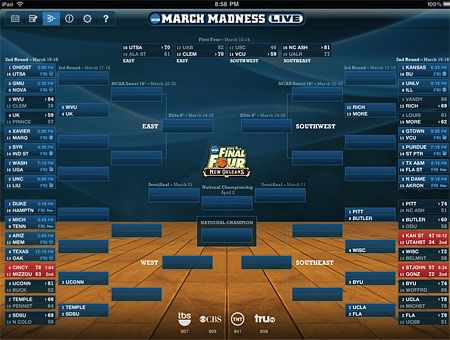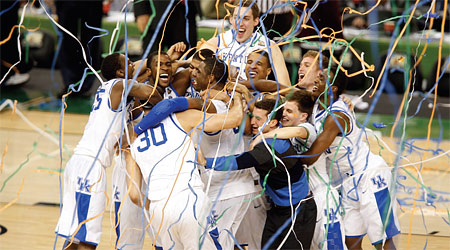In the March Madness Hot Seat
NEW ORLEANS: If you thought the slammin'-jammin' action during the 67 games of the NCAA's March Madness basketball championship series was exciting, check out the post production that was happening behind the scenes. The live video broadcasts sent over four networks—CBS, TBS, TNT and truTV—were enhanced by some of the most intensive post-production work of any national televised sports championship.

Access to all March Madness games was expanded this year through “NC AA March Madness Live,” produced by Turner Sports Interactive for iOS and Android platforms. "There's a ton of post production involved with the March Madness broadcasts both on CBS and the Turner networks," said Craig Barry, senior vice of creative and content at Turner Sports. "In addition to unique graphics and edited packages shown during the games themselves, we started creating promotional and marketing materials months before all the office pools began choosing their brackets. And we had used a lot of our synergies with CNN talent, Conan, Kevin Hart, and a lot of the CBS personalities to create this campaign that crossed over all platforms including both broadcast and internet channels."
SHARED RESPONSIBILITIES
Responsibilities for this were shared between the CBS Broadcast Center in New York and the Turner Sports Studios in Atlanta.
"We shared the post-production work based on the most efficient resources each partner had available," Barry said. "There was no real slide one way or the other based on which network was broadcasting what game."
The lion's share of editing and posting the promotional work was accomplished by the Turner entities, although the conceptual ideas were derived from cooperation of all broadcast participants.
As Barry explained, "There would be an image campaign saying which event was on the individual network, and then a topical campaign detailing the specific game and when and where it could be seen. It was a partnership from concept through execution to delivery on every facet of the championship production, from promotional marketing to game elements and, of course, the live games themselves."
The year, all the games were staggered so every fan had the opportunity to watch all of the games on one or the other network even if they were played at the same time. Access was expanded through the championship's multiple platform distribution beginning March 7, called "NCAA March Madness Live," which went by "March Madness on Demand" in the past, produced this year by Turner Sports Interactive. This included online, iPad, iPhone and iPod touch, and select Android smartphones over WiFi and 3G/4G thanks to a $3.99 app that could be downloaded from the Apple App store. The NCAA March Madness Live video player was presented by NCAA Corporate Champions AT&T, Capital One and Coke Zero.
"The games on March Madness Live were simulcasts from CBS or Turner network games, with some bumps to break or back to show inserted live in real time from our facilities," Barry said. "The online channels would provide stats, scores and highlights that were not always seen during over-the-air broadcasts."
To produce all these elements, the Turner Sports facilities in Atlanta had access to 60 Apple Final Cut Pro 7 edit suites with up to 12 working simultaneously on any given day, often in 20-hour shift cycles. Four FCP 7 edit bays would be dedicated just to creating teases, bumps and opens for March Madness Live, often dividing the work with their partners at CBS. The finishing on most of the promos and packages would be enhanced by specialists using Adobe After Effects, Autodesk Flame or Inferno, and Avid DS systems.
TWO AVENUES TO POST

Kentucky Wildcats celebrate a 67-59 win over the Kansas Jayhawks for the NC AA Final Four championship at the Superdome in New Orleans, April 2. Photo by Ted Jackson, Times Pacayune/Landov Barry has seen the post production process for sports evolve as the March Madness challenge has grown. "There are really two avenues of post production: the post that supports the live shows which is more topical and urgent, and the promotional and marketing work which allows more time for execution," he said. "Getting to a place where post production is totally tapeless, and having EVS machines with which you can create live packages on the fly has been a real benefit [in] improving the content and quality of our transmissions over the growing number of channels."
The four Final Cut Pro 7 edit bays dedicated to this year's March Madness Live highlight package post production are part of the Turner Sports Central system that was launched on Christmas Day 2011 to coincide with the opening of the delayed NBA season, according to Ken Brady, vice president of systems technology and digital media for Turner Studios.
"Previously we had four or five different live feed edit systems that we worked with," Brady said. "About a year ago we started the process that resulted in combining them into Turner Sports Central, and we will be adding the NBA television operation to the system this summer. Twenty-six channels of EVS handle the ingest recording with 16 playout and slo-mo channels under the control of Dalet central scheduling and asset management. The games are logged live under a purpose-built process designed for us by Stainless Code in Los Angeles."
This requires massive SAN storage, and the Turner Sports Central edit bays can access two mirrored discreet SANs holding 3 petabytes of data that will jump to 6 petabytes when the NBA operations join Turner Sports Central this summer.
"Since we are completely tapeless except for an occasional backup, this technology has made the post production process easier over the years," Brady said. "Having all that material and information available to everyone all the time lets us produce a better product for productions like March Madness and our whole roster of other sports productions. It's still a lot of stress on personnel and equipment, but we get the shows on the air."
The professional video industry's #1 source for news, trends and product and tech information. Sign up below.
